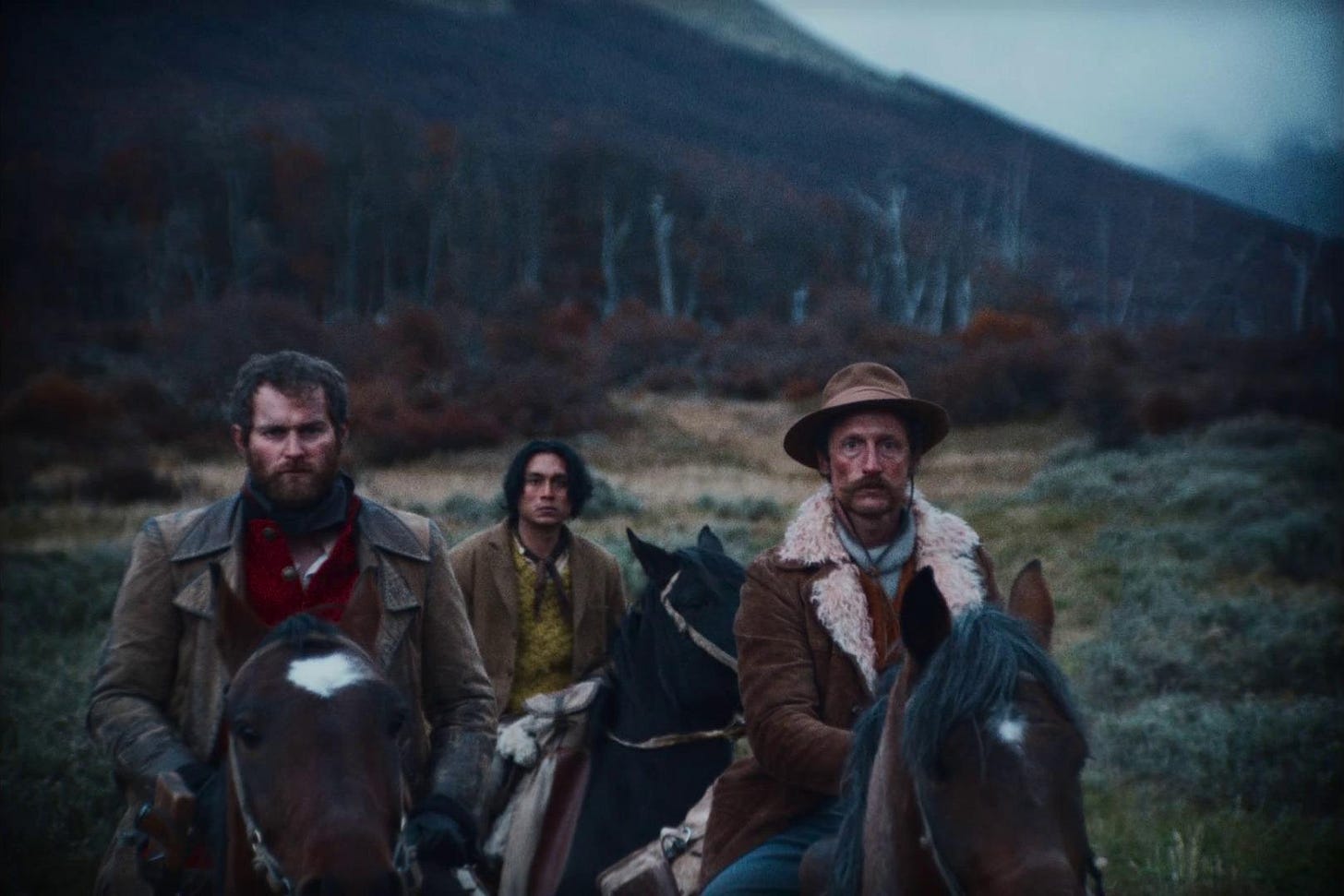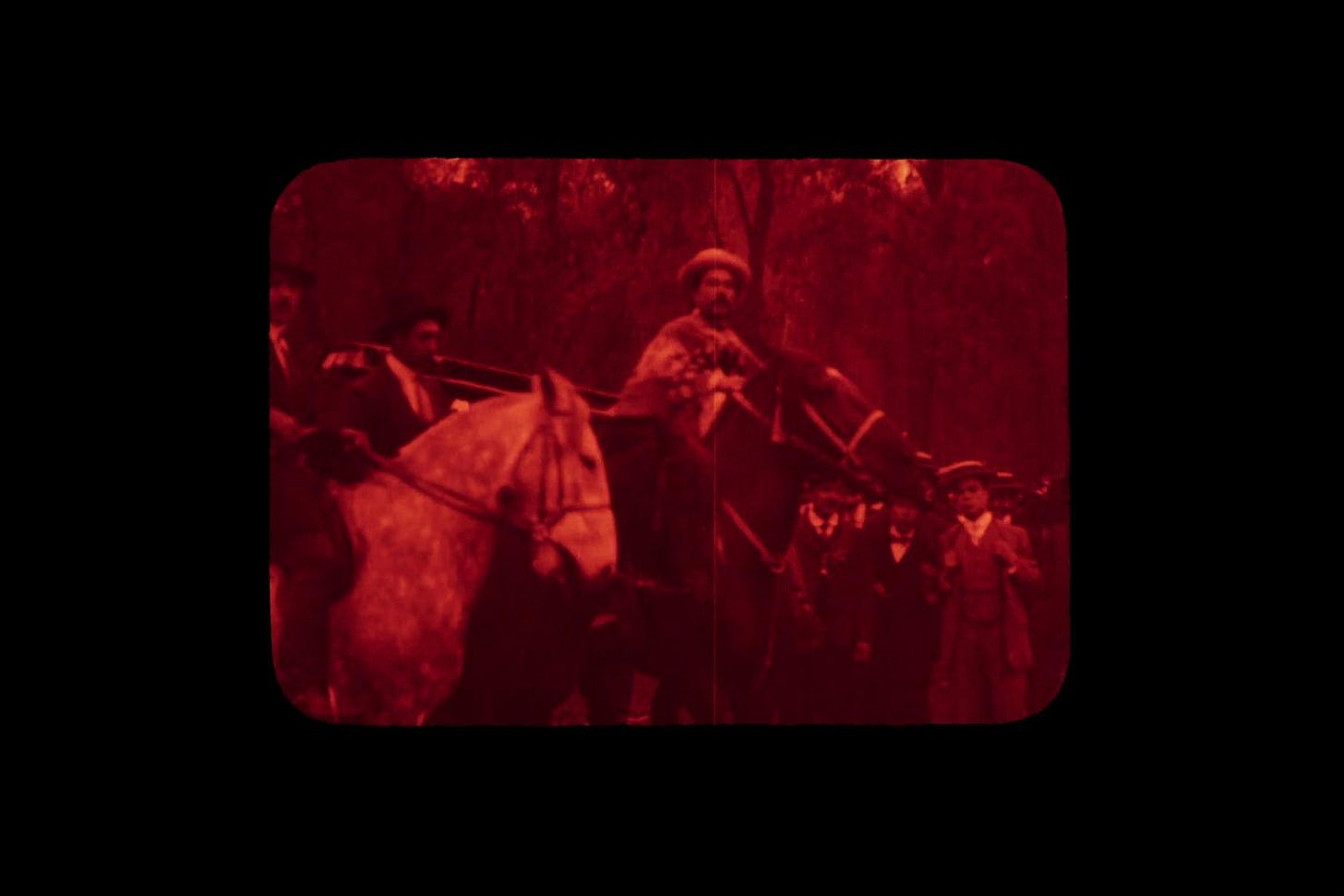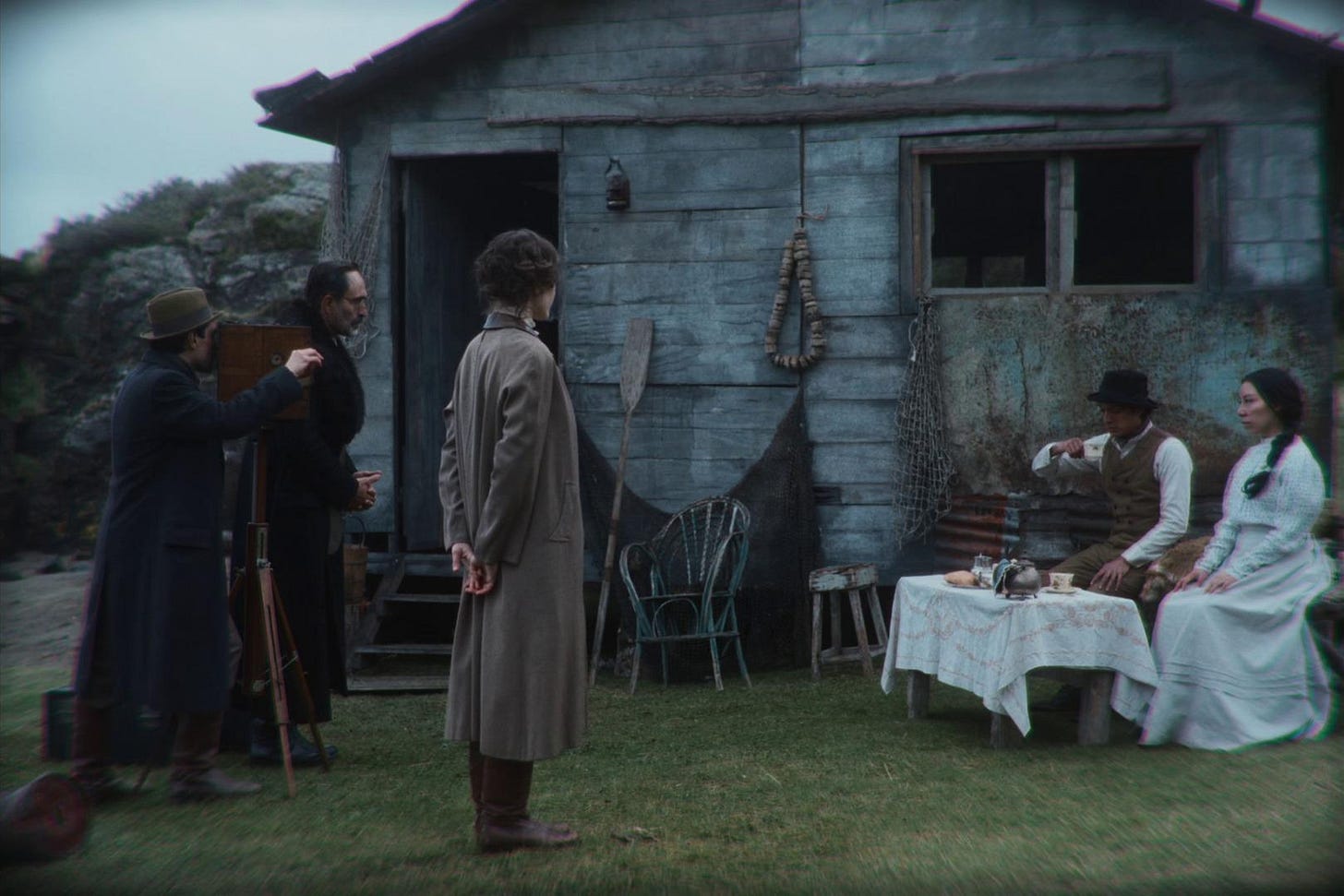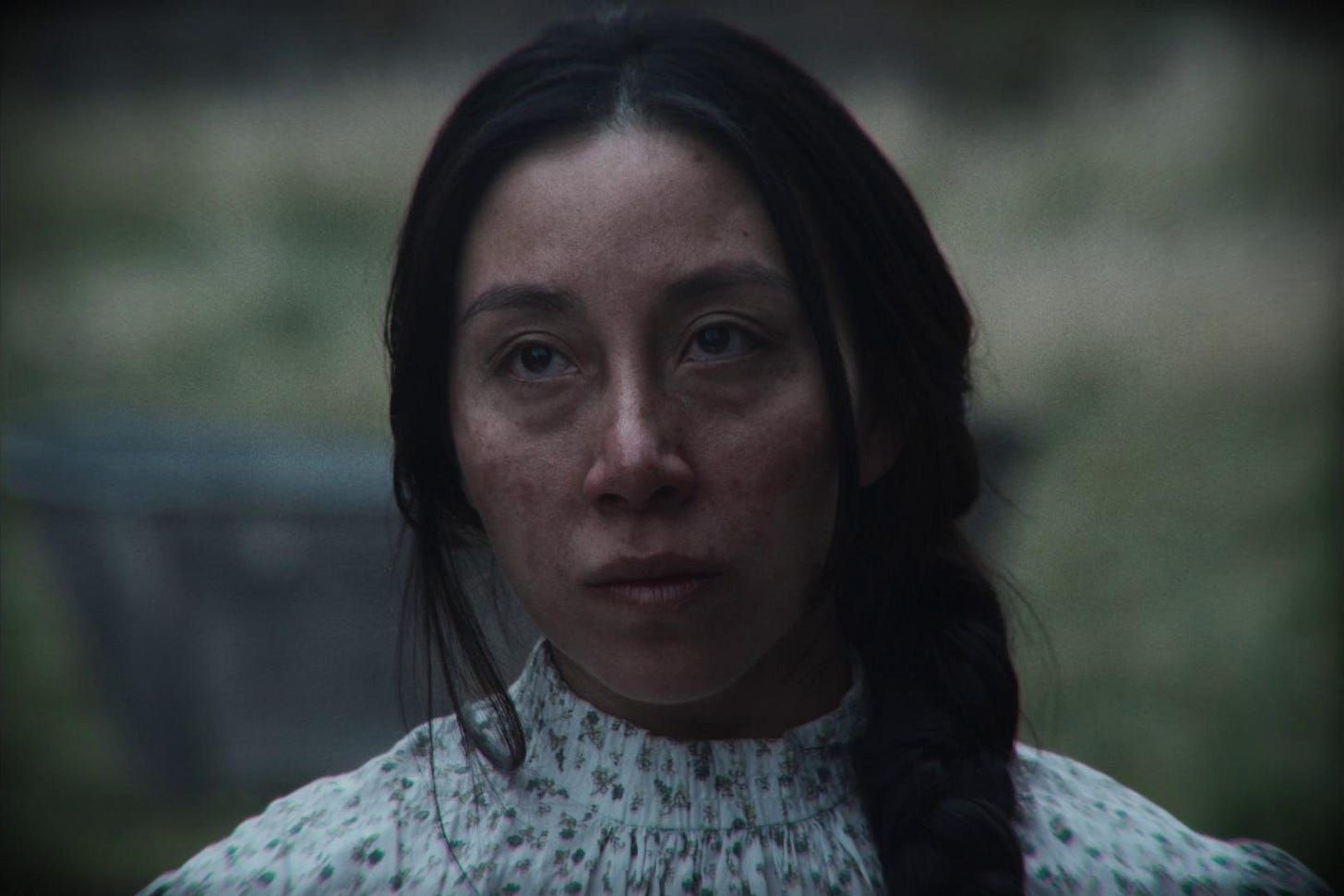Notes on The Settlers
Now I really feel bad about spoilers since this movie is recent and only streaming on Mubi

I started this project assuming there was pop culture that could help me make sense of our political moment. Part of this is factual; some art is created to represent an artist’s perspective on their context. But, as my first two posts have hopefully shown, is primarily normative: the art I am excited to write about is one I in some way am morally sympathetic to. E.T.’s fear of the state and Small Things Like These’s plea for serenity are moral emotions I find myself feeling in our political moment.
Implicit to that feeling is a sense that pop culture has — or at least, can have — a politics. If this is true, then we must ask whether we can evaluate art on political grounds and, crucially, whether we think good art can have bad politics.
I don’t think the answer to this is obvious. On the one hand, there’s a material dimension. Under capitalism, enjoying great art can also mean financially supporting Bad People. This is the classic problem of separating art from the artist. On the other hand, and supposing we have an answer to that question, we might imagine there is Great Art that is politically suspect. For those of you who share my politics, some examples might include Christopher Nolan’s Dark Knight trilogy, Picasso’s depiction of women, and the vast majority of Italian Renaissance art.
Of course, we can just say no, if art has bad politics, then it simply cannot be good. We can say the Dark Knight trilogy just is bad film art, Les Demoiselles d ’Avignon just is a bad painting, and Michelangelo’s Sistine Chapel just is a bad fresco. The list is endless. These don’t even account for art which, independent of its own politics, is used for political purposes. Richard Wagner’s compositions were famously used by the Third Reich for their own political purposes (Wagner himself was anti-Semitic, so perhaps he wouldn’t have objected to this).
I don’t think it’s that easy. Unfortunately, we don’t have a choice but to grapple with the fact that we may very well like art whose politics we abhor. Visiting the Vatican Museums was one of the most transformative moments of my life, but it was also…the Vatican.
All of this brings me to Felipe Gálvez Haberle’s 2023 film The Settlers. The movie portrays the genocide of Chile’s Indigenous people by using and upending the tropes of the Western movie genre, which Gálvez Haberle has argued was an “active accomplice to the colonization process in the Americas.”
The third act of the movie takes place seven years after the genocide. We find Segundo (Camilo Arancibia), the mixed-race man hired to assist the American mercenary and ex-British soldier who have been tasked with “clearing” the land owned by a wealthy Chilean, with his wife Kiepja (Mishell Guaña Montoya) at his home in the countryside, far removed from the urban (and urbane) politicians discussing the case of the genocide.
Kiepja is approached by an entourage led by Vicuña (Marcelo Alonso), a government official. He asks Kiepja if Segundo is home, who lies about his whereabouts. Upon discovering the truth, Vicuña threatens Kiepja with police force if she does not invite him into their home to speak with Segundo. Kiepja acquiesces.
Once inside, Vicuña reveals he is hoping to interview Segundo to include him in the process of telling the story of the genocide, “to do justice” to the many Indigenous people who were murdered. Ultimately, he asks to take “photographs, but in motion” of Segundo, hoping to add strength to Segundo’s testimony.
We aren’t shown the moment of agreement, but the film cuts to the “set,” where Vicuña and his team begin shooting a “scene.” Segundo and Kiepja are dressed in clearly Westernized attire. They are instructed to drink tea — the most refined (read: European) of beverages — while the camera is rolling. Kiepja merely sits still, where Segundo does drink the tea. The camera (both the one on screen and the one used for the movie) begins a slow zoom on Kiepja’s face, stony and uncompromising.
At this point in the movie, the viewer would be forgiven for thinking this movie is unambiguously critical of the genocide of Indigenous people and of film’s power to critique such historical moments. Then two things happen, in quick succession, that complicate that reading.
First, Vicuña loses his patience with Kiepja, asking “Rosa [the name she used to introduce herself to the white men], do you want to be part of this nation?”1 Without ever seeing whether or not Kiepja drinks the tea, the film cuts to black and then proceeds to show a film reel, tinted red, which we are meant to understand is the film Vicuña has been creating. It opens with a shot of the Chilean flag, proudly billowing in the wind, and proceeds to intercut various scenes of daily life in Chile: cityscapes, landscapes, families, crowds, trains, and ships. None of these scenes include the scene that Vicuña is depicted as filming.
Film is and can be political, but it is not necessarily politically good.
These final moments really challenge what it is we think film can do for us as a political tool. Film is and can be political, but it is not necessarily politically good. In the last seconds of the film, Vicuña plays his hand, out of exasperation with a resistant Kiepja: this project is to build the nation, but a nation that is assimilated to codes of whiteness. The red tint of the film reel stands in for the blood spilled to build that nation. And, most importantly, the Segundo and Kiepja’s absence from the final film reel is an emphatic “no” to Vicuña’s question. They do not want to be a part of the nation that Vicuña is building.

Most importantly, Gálvez Haberle indicates that film as a medium has played a critical role in creating our historical narratives, deciding who we include and don’t include in our respective nations. Indeed, in an interview with Rolling Stone, he says as much: “The movies reflects on the relationships between reality and fiction, and how film can mold and transform the perception of historical events.”2
Film is political; art is political. But the question about the relationship between good politics and good artmaking, I think, remains open. The Settlers only forces us to think about it a little harder.
—
Tennis season is back! The Australian Open starts on Monday so for my recommendations this week, I’m focusing on three tennis-related items.
Something I’ve seen: I just started a subscription to the Tennis Channel, and I discovered that the 2018 documentary Strokes of Genius lives there. I’m not a fan of the documentary genre, but I know of no better way to learn about tennis history than through watching clips of important tennis moments and listening to the people involved. The 2008 Wimbledon final between Roger Federer and Rafael Nadal is one of those important tennis moments and this documentary captures it well.
Something I’ve read: The Inner Game of Tennis changed how I approach playing tennis and probably much else.
Something I’ve listened to: “Forever, you will be someone who pled guilty to abusing your girlfriend.” Former tennis world #1 and US Open champion Andy Roddick, on the eve of the Australian Open and Nick Kyrgios’s return to professional tennis, tears into Kyrgios after the Australian rallied a throng of trolls onto 16-year-old Cruz Hewitt’s post playing with world #1 Jannik Sinner. Well worth a listen, if you dislike Kyrgios as much as I do (and even if you don’t).
My translation would be slightly different from the captions on Mubi. The Spanish is, “Rosa ¿usted quiere o no quiere ser parte de esta nación?” The phrasing used in Spanish reflects the exasperation, even without the actor’s intention. A more literal translation, then, would be “Rosa, do you or do you not want to be part of this nation?” This phrasing, which reminds me of an exasperated parent, more accurately depicts the paternalist relationship the colonizers have with the Indigenous population.
My translation.



